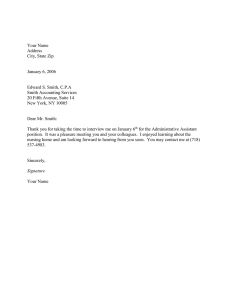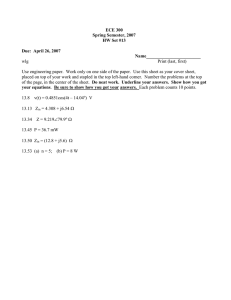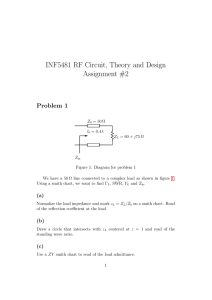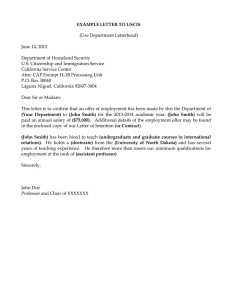ECE 3300 SMITH CHARTS Smith Chart Circles: A Smith chart is a
advertisement
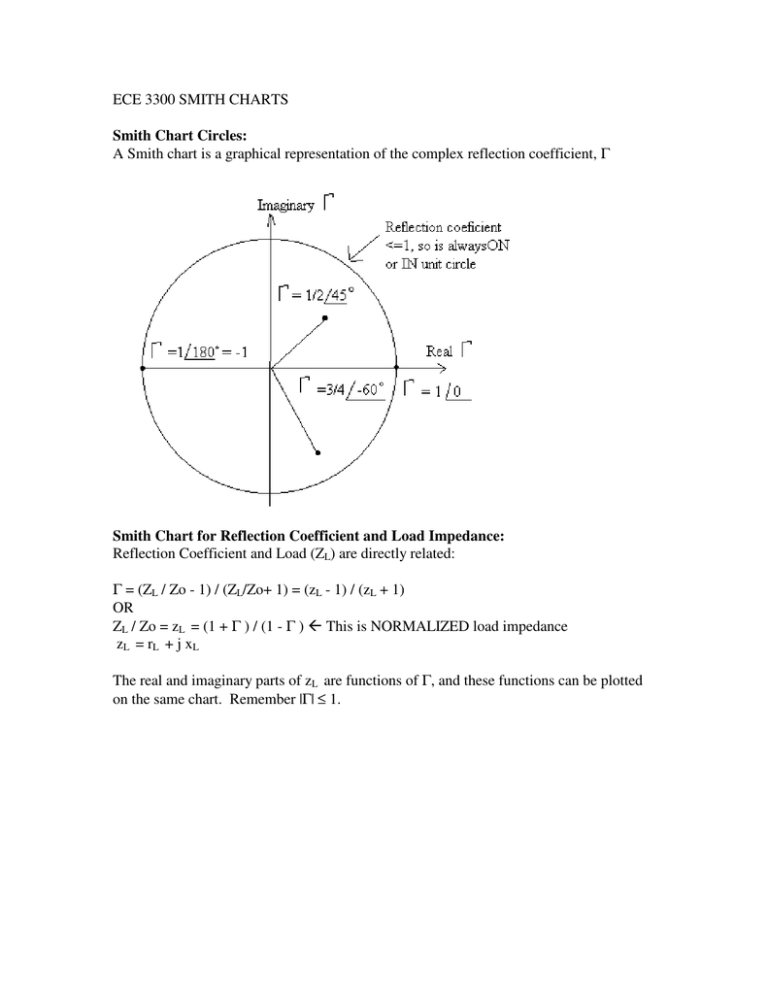
ECE 3300 SMITH CHARTS Smith Chart Circles: A Smith chart is a graphical representation of the complex reflection coefficient, Γ Smith Chart for Reflection Coefficient and Load Impedance: Reflection Coefficient and Load (ZL) are directly related: Γ = (ZL / Zo - 1) / (ZL/Zo+ 1) = (zL - 1) / (zL + 1) OR ZL / Zo = zL = (1 + Γ ) / (1 - Γ ) This is NORMALIZED load impedance zL = rL + j xL The real and imaginary parts of zL are functions of Γ, and these functions can be plotted on the same chart. Remember |Γ| ≤ 1. Example: Given ZL , find Γ using Smith Chart See transparencies (Copies to be made available in copy room) How to find Γ : 1) Find Normalized load Impedance, zL = ZL / Zo = rL + j xL 2) Find intercept of semicircles for rL and xL and PLOT zL 3) Draw line from center of smith chart to (or through) zL 4) Read angle of Γ from outside of Smith chart 5) Measure | Γ | with a protractor and compare to line on bottom of smith chart labeled “Ref. Coeff. E or I” Zo = 100 ohms ZL = open circuit zL = ∞ = ∞ + j 0 PLOT (far right) Draw Line through zL . Read ∠0 Measure using a protractor (or this one is obviously =1) | Γ | = 1 Γ =1 ∠ 0 (which is what we expect for an open circuit) 1) 2) 3) 4) ZL = short circuit zL = 0 = 0+ j 0 PLOT (far left) Draw Line through zL . Read ∠180° Measure using a protractor (or this one is obviously =1) | Γ | = 1 Γ =1 ∠ 180° = -1 (which is what we expect for an short circuit) 1) 2) 3) 4) ZL = 100 + j 0 ohms zL = ZL / Zo = 1 + j 0 PLOT (center of smith chart) Draw Line through zL . Not so easy … ∠? Measure using a protractor (or this one is obviously =0) | Γ | = 0 Γ =0 ∠ ? (which is what we expect for a matched load) 1) 2) 3) 4) ZL = 100 + j 100 ohms zL = ZL / Zo = 1 + j 1 PLOT (top right quadrant) Draw Line through zL . about ∠63° Measure using a protractor | Γ | = 0.45 Γ =0.45 ∠63° 1) 2) 3) 4) Γ = (zL - 1) / (zL + 1) = (0+j1) / (2+j1) =1∠90° / 2.236 ∠26.56 ° = 0.45 ∠63.43° How do you find load impedance if given Γ? 1) Plot Γ 2) Read zL = zL +j zL 3) Unnormalize: ZL = zL * Zo Admittance vs. Impedance: Admittance yL = 1 / zL Γ = (zL - 1) / (zL + 1) = (1/yL - 1) / (1/yL + 1) = - (yL - 1) / (yL + 1) = 180 out of phase Steps to find Γ from yL: 1) Find normalized yL = Zo / ZL = gL +jbL 2) Plot it (Using same curves g=r and b=x) 3) “Transform it through the origin” … Rotate 180 degrees = draw a line of equal length through the origin. Now you have found zL 4) Read Γ as before EXAMPLE (See transparencies) Input Impedance: Zin = Zo [1 + Γ e –j2βl ] / [1 - Γ e –j2βl ] zin = Zin / Zo = [1 + Γ e -j2βl ] / [1 - Γ e -j2βl ] Define reflection coefficient at the input (NOT Γg ) as the reflection coefficient looking into the load frm the input location. Γl = ΓL ∠-2βl This represents moving 2βl radians towards the generator. You can convert this distance to degrees, and read it off the outer circles on the Smith Chart (notice DIRECTION to the generator is marked) OR 2βl = 2(2π / λ) l = 4π (l / λ) This has been normalized for you on the outside circle around the Smith Chart. Observe that if l=λ, this represents 2 complete rotations around the Smith Chart. L = λ/2 represents one complete rotation. Does this make sense? For a Transmission line of length L = λ/2, traveling from generator to the load and back would represent a phase shift of 360 degrees … one complete rotation. Then zin = [1 + Γl] / [1 - Γl ] How to find Zin : 1) Normalize zL = ZL / Zo 2) Plot zL. This also gives you ΓL. 3) Rotate Γ distance l (given in wavelengths) TOWARDS the generator. 4) Read zin and Γl 5) Zin = zin * Zo EXAMPLE (see transparencies) Standing Wave Ratio: To read SWR from the Smith Chart: 1) PLOT zL 2) 3) Draw a circle through it. Read SWR from real axis to right (SWR ≥ 1) EXAMPLE (See transparencies) Voltage Minima and Maxima: To read Voltage maxima off Smith Chart: PLOT zL 1) 2) First Voltage maximum occurs on right side of real axis. First Voltage minimum occurs on left side of real axis. EXAMPLE (See transparencies)
